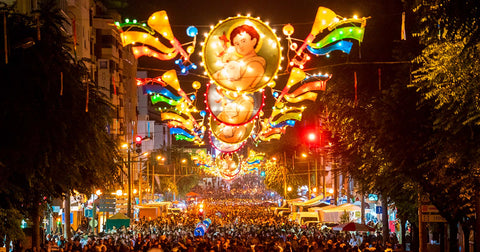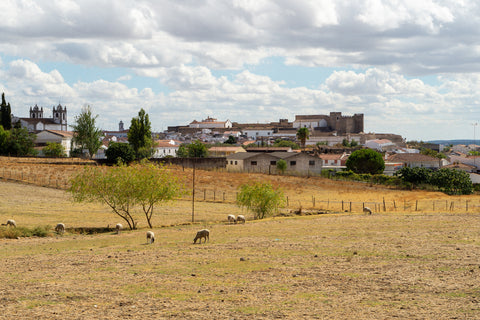If you are planning a visit to Portugal during the month of June, you will have the chance to participate in one of the most festive and colorful events in Europe : the Popular Saints Festival or "Festas dos Santos Populares". These are very lively celebrations, where people invade the streets to eat, drink and have fun in the popular neighbourhoods decorated with multi-colored arches and balloons and pots of aromatic-smelling basil.
The Popular Saints Festival is dedicated to three highly venerated saints: Saint Anthony of Lisbon/Padua (Santo António), Saint John the Baptist (São João) and Saint Peter (São Pedro). The main festivities are those of Lisbon, which take place on the night of June 12-13, the feast day of Saint Anthony of Lisbon, and the festivities of Porto, celebrated on the night of June 23-24, the feast day of Saint John.
Every year, thousands of tourists flock from all over to take part in these unique celebrations, discover Portuguese culture and enjoy local hospitality, reminding everyone of the richness and vibrant culture of Portugal.

| Photo credit: www.visitportugal.com |
The feast of Saint Anthony
Saint Anthony is venerated by the Portuguese who celebrate his feast day on June 13. Born in Lisbon around 1195, Saint Anthony was baptized as Fernando de Bulhões. He chose the name António when he entered the Franciscan order. Patron saint of fishermen, pregnant women, sailors, travelers, farmers and the elderly, he is also known for his eloquent sermons and his ability to find lost objects.
The feast of Saint Anthony is particularly lively in Lisbon, where colourful parades, street balls and mass weddings ("Casamentos de Santo António", or Saint Anthony weddings) enliven the city.

According to legend, the feast of Saint Anthony has its origins in a 13th-century event when Saint Anthony visited Rimini, Italy. His trip did not go as planned and, seeing that the people of Rimini were not very receptive to his sermons, he decided to preach to fish instead. To everyone's amazement, rows of fish emerged from the water, attentive to the saint's words. Today, the Portuguese commemorate this legend by holding huge street parties where they eat grilled sardines.
Tradition has it that on the eve of the feast of Saint Anthony , the districts of Lisbon are transformed and adorned with colourful decorations. The bohemian district of Alfama is at the heart of the animation, but the crowds and the animation are also considerable in the popular districts of Graça, Bica, Mouraria or Madragoa .
Traditional gastronomy plays a central role in the celebrations - food and drink stalls appear on street corners, ready to serve the thousands of party-goers all night long. In the squares and alleys, people eat “caldo verde” (green cabbage soup with smoked sausage) and grilled sardines, the smell of which fills the streets, inviting visitors to join the locals in this festive evening. As the smell of grilled sardines and folk music fills the air, locals watch the scene from their balconies decorated with light bulbs, garlands and lanterns.
During this period, the streets of Alfama are also the scene of many activities, such as decorated window contests, sardine races, processions and street markets. Lisbon 's churches also hold religious celebrations in honour of Saint Anthony.

The Feast of Saint John the Baptist
Saint John the Baptist is celebrated on June 24 and is the patron saint of many cities. The night of Saint John, or "Noite de São João", is one of the most anticipated festivals in Portugal, mainly in the city of Porto where the party reigns with the same colours and expressions of joy.

|
Saint John | Grão Vasco National Museum – Viseu, Portugal
|
The festivities include spectacular fireworks launched at midnight over the Douro River, hot air balloons, concerts and dances in the most typical neighbourhoods, such as Miragaia, Fontainhas, Ribeira, Massarelos , among others. The cultural programme extends to several districts of Porto, but it is in Ribeira and around the Palácio de Cristal that the main attractions are concentrated. There are typical food stalls, musical performances and plenty of entertainment for every age group.
In Porto, tradition requires party-goers to gently hit passers-by or their companions on the head with plastic hammers (in the past, leeks were used), a custom that is said to bring luck and happiness.
The feast of Saint Peter
Saint Peter's Day is celebrated on June 29. Being the patron saint of fishermen, celebrations often include maritime processions where fishing boats are decorated and blessed.
The feast of Saint Peter is held in different locations in the country, with particular importance in coastal regions such as Póvoa de Varzim and Sintra , or in Évora , the largest city in Alentejo. In fact, Évora has the particularity of celebrating two popular saints - since the 16th century, it has held the Saint John Fair, one of the most important in the South of Portugal, and also commemorates Saint Peter, which is also a municipal holiday. The feast of Saint Peter marks the end of the festivities with bonfires and dances.

Traditions and parades
The Popular Saints' Days are marked by a multitude of traditions and festive activities that vary slightly from one region to another, but which all share a spirit of community and joy.
In Lisbon, the parades, or "marchas populares", are one of the highlights of the celebrations. Each neighbourhood participates with its own parades during which groups of dancers dressed in traditional costumes march while singing folk songs. The parades are often accompanied by competitions between neighbourhoods, adding a touch of friendly rivalry to the event. The other highlight of these popular festivities is the procession of Saint Anthony who, on June 13, leaves his church located in Alfama near the Cathedral (Sé), the place where this saint was born.

| Photo credit: www.visitportugal.com |
Throughout the festivities, it is also customary to jump over bonfires, an ancient tradition linked to the summer solstice celebrations intended to attract good luck and ward off evil spirits. Another tradition is to offer to the chosen one of his heart pots of basil ("manjericos") with an aromatic scent, decorated with small coloured papers on which are often written romantic verses, since these festivals are also associated with ancient fertility rites.

|
Photo credit: www.visitportugal.com
|
In short, the Popular Saints Festival is a vibrant reflection of Portuguese culture and traditions. It celebrates community, the joy of living and Portugal’s religious heritage. Whether jumping over bonfires, eating grilled sardines or participating in colourful parades, these fiery celebrations offer an unforgettable experience for locals and visitors alike.
And you, what was your highlight during the Popular Saints Festival? Share your experience with us in the comments!



Comments (0)
There are no comments for this article. Be the first one to leave a message!